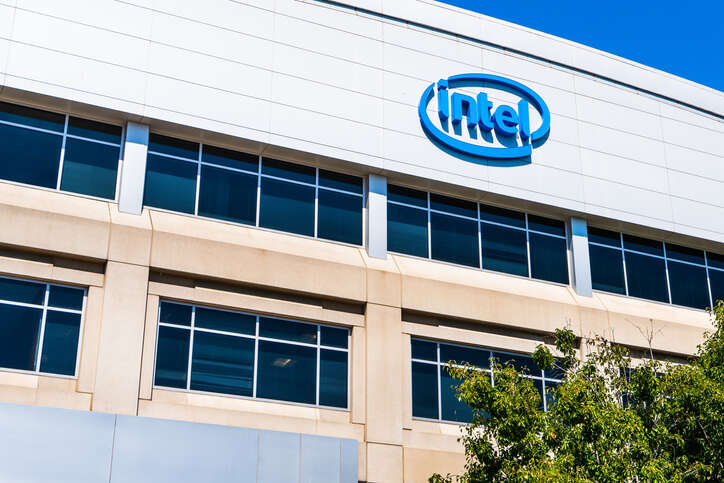
Once revered as the world’s biggest manufacturer of semiconductors, Intel is now a shadow of its former self. The global chip shortage, together with a historic slump in PC sales and the ongoing tech war between the US and China, have all contributed to the company’s steady decline in recent years. And as Intel attempts to rebuild itself by restructuring its workforce, the company is currently also assailed by patent lawsuits by other chipmakers. As if things couldn’t get any worse, the head of Intel’s foundry services arm, Randhir Thakur, recently resigned just as the company began to revamp itself, according to The Register.
New data reveals how Intel has been dethroned as the world’s biggest semiconductor company, losing ground to historic rivals like AMD and Nvidia. One of the primary reasons for its tanking stock price over the past year has been a massive drop in demand for PCs. As a result, Intel stocks have been in freefall since the start of the year, dropping by 45% to hit $27 in mid-October – its lowest level since August 2015, according to Yahoo Finance. For added comparison, the company’s stock prices are also 60% lower than its highest levels last year.
According to Intel’s most recent filings, PC notebook sales in Q3 are down by 26% compared to the same quarter last year. And as inflation continues to bite, tech companies are looking to rein in IT spending by focusing on more immediate business challenges. Intel is not alone in this regard. One of its competitors, Hewlett Packard, is also suffering from its significant exposure to the slowing demand in the PC market. In the company’s Q3 report, revenue from its personal systems segment which provides the bulk of company income was down by 13%.
Against this backdrop, Intel’s chief executive Pat Gelsinger has struck a defiant tone. “Despite the worsening economic conditions, we delivered solid results and made significant progress with our product and process execution during the quarter,” he said. “To position ourselves for this business cycle, we are aggressively addressing costs and driving efficiencies across the business to accelerate our IDM 2.0 flywheel for the digital future.”
But despite the grim macroeconomic outlook, Intel’s stock did appear to rally when the US CHIPS Act was signed into law in early August. The landmark piece of legislation is designed to boost American domestic production by cutting off China’s access to Western chips - a policy that Intel is betting its future on. Earlier this year, the semiconductor giant published a report explicitly urging the US government to move forward with the CHIPS Act.
“American businesses in every sector across the economy are facing a semiconductor shortage,” the report said. “The only way to alleviate the current supply-demand imbalance and to prevent future shortages is to increase manufacturing capacity; funding the CHIPS for America Act is a critical component to enable that.”
The pot of money in the CHIPS Act reserved for boosting domestic semiconductor manufacturing reportedly stands at $52bn. It is clear that Intel will be one of its main beneficiaries. Some analysts have speculated that the company could receive up to $15bn worth of US government subsidies in the next five years while also reaping the benefits of similar reshoring policies in Europe.
Whether this would be enough to plug the hole left in Intel’s profit margins from exiting the China market is unclear. According to the firm’s annual report at the end of last year, China was the company’s biggest export market by a significant margin. Between 2019 and 2021, Intel sold more than $60bn worth of chips, computers and data centre equipment to China, with the Singaporean market coming second at $48bn. For comparison, sales to American entities totalled $46.2bn in the same period.
The impact of the CHIPS Act on Intel’s business in China may become clearer towards the tail end of next year. Last month, the company announced that it received an exemption to continue its NAND memory chip operations at its factory in Dalian, China which would last for just one year. This represents a significant change in the company’s plans, as it announced last year that its operations at the Dalian plant would last till 2025.
As Intel continues to grapple with the geopolitical ramifications of the CHIPS Act, its main rivals in the semiconductor industry appear to be racing ahead. The company’s recent filings reveal how revenues for Q3 totalled $15.3bn, down by 20% when compared to the same quarter last year. Meanwhile, the filings also revealed how profits are similarly trickling away, with $1.02bn reported this quarter, compared to $6.8bn last year.
The company’s historic rival AMD, on the other hand, appears to be thriving amidst uncertain macroeconomic conditions. In Q3, AMD reported revenues have surged by almost 30% compared to the same quarter last year. Nvidia, meanwhile, reported an increase in profit of 50% during the same period, according to Tech Monitor’s analysis of company filings.
While the slump in PC sales is also affecting AMD, the firm has less exposure to the Chinese market compared to Intel. According to the company’s recent filing to the US Securities and Exchange Commission, AMD’s sales to China totalled approximately just $4.1bn last year. “When we look at the most recent regulations, they’re not significantly impacting our business,” Lisa Su, the chief executive of AMD, recently told CNBC. “It does affect some of our highest-end chips that are used in sort of AI applications. And, we were not selling those into China.”
But Intel’s recent decline also reveals a more fundamental issue with the company with regard to its innovation in manufacturing. According to the International Institute for Management Development which tracks the future-readiness of the world’s biggest tech companies, Intel currently ranks sixteenth out of 27 in the world, far behind AMD and NVIDIA, which sit in fifth and sixth place respectively. In Intel’s earnings call with analysts at the end of Q4 last year, the company’s CEO Pat Gelsinger conceded that the technology in its data centre processors has not improved in the last five years. It was, he said, “an embarrassing thing to say”.
Read more: The real winners of the chip wars are in East Asia
Homepage image: Shutterstock






